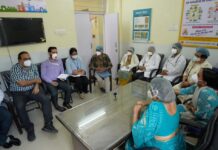 NEW DELHI: Delhi’s air quality remained “very poor” on Monday due to slow wind speed and high humidity, authorities said even as a study pointed out that during the past two decades, Delhi’s air quality was the “most deadly” in 2016 as it reduced the life expectancy of a resident by over 10 years.
NEW DELHI: Delhi’s air quality remained “very poor” on Monday due to slow wind speed and high humidity, authorities said even as a study pointed out that during the past two decades, Delhi’s air quality was the “most deadly” in 2016 as it reduced the life expectancy of a resident by over 10 years.
Even as the study asserted that the national capital was the second among 50 most polluted areas of the country, the Supreme Court-empowered Environment Pollution (Prevention and Control) Authority (EPCA) Chairman Bhure Lal said enforcing agencies were “completely dormant” and bodies like the DDA and the MCD were indulging in a blame game.
Speaking at an event, Lal stressed on the need to strengthen public transport, especially the bus fleet, while asserting that there was a “laxity of administration” in adopting measures for combating pollution.
North Delhi Mayor Adesh Gupta, however, rejected the allegation saying, the civic body “follows all instructions” as directed by the apex court-appointed monitoring committee while DDA Vice-Chairman Tarun Kapoor said the urban body discharged all its duty diligently.
Lal had recently recommended to pollution watchdog CPCB that it should implement either the odd-even scheme or impose a complete ban on non-CNG private vehicles if the air pollution level in Delhi increases again.
According to the Centre-run System of Air Quality and Weather Forecasting (SAFAR), the overall air quality index (AQI) was recorded at 326, which comes under the “very poor” category. However, the Central Pollution Control Board (CPCB) data said 20 areas in Delhi recorded “very poor” air quality and 13 recorded “poor” air quality.
On Monday, the PM2.5 particles in the air with a diameter of less than 2.5 micrometres level was recorded at 174, while the PM10 level was recorded at 320, the CPCB data said.
The air quality in Ghaziabad, Faridabad, Noida and Greater Noida was “poor” while Gurgaon recorded “moderate” air quality, it said.
An AQI between 0 and 50 is considered “good”, 51 and 100 “satisfactory”, 101 and 200 “moderate”, 201 and 300 “poor”, 301 and 400 “very poor”, and 401 and 500 “severe”.
Air quality is very poor and expected to increase gradually in the next two to three days but well within the “very poor” limit, the SAFAR said in a report.
“At present, winds are unfavourable for dispersion but it may slow down any time with fall in temperature, which is expected. Humidity is still high which is unfavourable. Fire counts from stubble burning declined and will have marginal impact,” it said.
Meanwhile, according to air quality life index and accompanying report produced by the Energy Policy Institute at the University of Chicago (EPIC), during the past two decades, Delhi’s air quality was the “most deadly” in 2016 as it reduced the life expectancy of a resident by more than 10 years.
The study said the national capital was the second among 50 most polluted areas of the country, while adding that India is today the world’s second most-polluted country trailing only Nepal.
It pointed out that loss of life expectancy was the highest in Asia, exceeding six years in many parts of India and China. The study said globally particulate pollution reduces average life expectancy by 1.8 years, making it the greatest global threat to human health.
“By comparison, first-hand cigarette smoke leads to a reduction in global average life expectancy of about 1.6 years. The impact of particulate pollution on life expectancy is comparable to that of smoking, twice that of alcohol and drug use, three times that of unsafe water, five times that of HIV/AIDS, and more than 25 times that of conflict and terrorism,” it said.
The study pointed out that over the past two decades, the concentration of fine particulates increased by 69 per cent on an average across India, reducing the life expectancy of a typical Indian citizen by 4.3 years compared to 2.2 years in 1998.
It said concentrations of particulate pollution in India’s northern states of Bihar, Uttar Pradesh, Haryana, Punjab and the National Capital Territory of Delhi are “substantially higher” and the impact on life expectancy exceeds six years.
It said pollution is the “single greatest threat” to human health globally, with its effect on life expectancy exceeding that of devastating communicable diseases such as tuberculosis and HIV/AIDS, behavioral killers like cigarette smoking, and even war.
Seventy-five per cent of the global population or 5.5 billion people live in areas where particulate pollution exceeds the WHO guideline.
“The AQLI reveals that India and China, which make up 36 per cent of the world’s population, account for 73 per cent of all years of life lost due to particulate pollution,” it said.
In Delhi, the PM2.5 concentration was 114 g/m3 in 2016 which is 1.6 times more than 70 g/m3 in 1998, the study said.
In Bulandshahr, the PM2.5 concentration was 124 g/m3 in 2016, which is 1.6 times more than 70 g/m3 in 1998, it said.
The AQLI is based on a pair of peer-reviewed studies that quantify the causal relationship between long-term human exposure to particulate pollution and life expectancy. PTI






